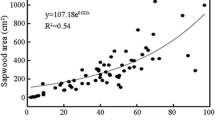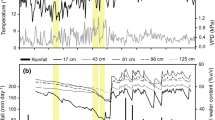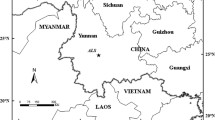Abstract
Key message
Highly variable nighttime transpiration, with higher rates generally observed after preceding fog, is prevalent in dominant tree species of the nutrient-poor tropical montane cloud forest environment of central Veracruz, Mexico.
Abstract
Although nighttime transpiration (E n) is prevalent in a wide range of species from cloud-affected forests, its magnitude relative to total daily transpiration (E d) as reported in the literature is generally small (E n/E d is 0.12 on average). In the present study, we observed high dry-season E n/E d ratios with large night-to-night variation in dominant species from the tropical montane cloud forest (TMCF) zone of central Veracruz, Mexico: 0.22 ± 0.18 for Quercus lancifolia (old-growth TMCF); 0.26 ± 0.14 and 0.16 ± 0.16 for Alchornea latifolia and Alnus jorullensis, respectively (regenerating post-fire TMCF); and 0.30 ± 0.20 to 0.12 ± 0.21 for Pinus patula (young and mature pine plantations). E n was determined as the difference between observed nocturnal sap flow and estimated refilling of stem water storage, the latter of which was on average: 21–25 % of nocturnal sap flow for Q. lancifolia; 6 and 5 % for A. latifolia and A. jorullensis, respectively; and 21–23 % for P. patula. Night-to-night variation in E n was mostly due to large variation in vapor pressure deficit (VPD) related in turn to the alternation of cold fronts (producing fog events) and high pressure weather (producing nights with VPD up to 2 kPa). Moreover, in the hours following fog events without concurring rainfall, E n was often higher as compared to fog-free nights with similar VPD across all species examined. Low-nutrient availability and high water content of the soils in the study area suggest a nutrient uptake benefit associated with the relatively high E n rates observed.





Similar content being viewed by others
References
Alvarado-Barrientos MS, Hernández-Santana V, Asbjornsen H (2013) Variability of the radial profile of sap velocity in Pinus patula from contrasting stands within the seasonal cloud forest zone of Veracruz, Mexico. Agric Forest Meteorol 168:108–119
Alvarado-Barrientos MS, Holwerda F, Asbjornsen H, Dawson TE, Bruijnzeel LA (2014) Suppression of transpiration due to cloud immersion in a seasonally dry Mexican weeping pine plantation. Agric For Meteorol 186:12–25
Ambrose AR, Sillett SC, Dawson TE (2009) Effects of tree height on branch hydraulics, leaf structure and gas exchange in California redwoods. Plant Cell Environ 32:743–757
Ambrose AR, Sillett SC, Koch GW, Van Pelt R, Antoine ME, Dawson TE (2010) Effects of height on treetop transpiration and stomatal conductance in coast redwood (Sequoia sempervirens). Tree Physiol 30:1260–1272
Barradas VL, Cervantes-Pérez J, Ramos-Palacios R, Puchet-Anyul C, Vásquez-Rodríguez P, Granados-Ramirez R (2010) Meso-scale climate change in the central mountain región of Veracruz State, Mexico. In: Bruijnzeel LA, Scatena FN, Hamilton LS (eds) Tropical montane cloud forests: science for conservation and management. Cambridge University Press, Cambridge, pp 549–556
Benner J, Vitousek PM, Ostertag R (2010) Nutrient cycling and nutrient limitation in tropical montane cloud forests. In: Bruijnzeel LA, Scatena FN, Hamilton LS (eds) Tropical montane cloud forests: science for conservation and management. Cambridge University Press, Cambridge
Benyon RG (1999) Nighttime water use in an irrigated Eucalyptus grandis plantation. Tree Physiol 19:853–859
Blakemore LC, Searle PL, Daly BK (1987) Methods for chemical analysis of soils. New Zealand Soil Bureau Sci. Rep. 80, Lower Hutt, New Zealand
Bray RH, Kurtz L (1945) Determination of total, organic, and available forms of phosphorus in soils. Soil Sci 59:39–46
Bruijnzeel LA, Veneklaas EJ (1998) Climatic conditions and tropical, montane forest productivity: the fog has not lifted yet. Ecology 79:3–9
Bruijnzeel LA, Mulligan M, Scatena FN (2011) Hydrometeorology of tropical montane cloud forests: emerging patterns. Hydrol Proc 25:465–498
Burgess SSO, Dawson TE (2004) The contribution of fog to the water relations of Sequoia sempervirens (D. Don): foliar uptake and prevention of dehydration. Plant Cell Environ 27:1023–1034
Burgess SSO, Adams M, Turner NC, Beverly CR, Ong CK, Khan AAH, Bleby TM (2001) An improved heat pulse method to measure low and reverse rates of sap flow in woody plants. Tree Physiol 21:1157
Caird MA, Richards JH, Donovan LA (2007) Nighttime stomatal conductance and transpiration in C-3 and C-4 plants. Plant Physiol 143:4–10
Chu HS, Chang SC, Klemm O, Lai CW, Lin YZ, Wu CC, Lin JY, Jiang JY, Chen J, Gottgens JF, Hsia YJ (2012) Does canopy wetness matter? Evapotranspiration from a subtropical montane cloud forest in Taiwan. Hydrol Proc 28(3):1190–1214. doi:10.1002/hyp.9662
Cruz-Martínez S (2010) Relaciones alométricas para la predicción de área foliar apartir del área basal en especies de bosque mesófilo de Coatepec, Veracruz. BS Thesis. Instituto Tecnológico del Valle de Oaxaca, Oaxaca
Daley MJ, Phillips NG (2006) Interspecific variation in nighttime transpiration and stomatal conductance in a mixed New England deciduous forest. Tree Physiol 26:411–419
Dawson TE, Burgess SSO, Tu KP, Oliveira RS, Santiago LS, Fisher JB, Simonin KA, Ambrose AR (2007) Nighttime transpiration in woody plants from contrasting ecosystems. Tree Physiol 27:561–575
Donovan L, Linton M, Richards J (2001) Predawn plant water potential does not necessarily equilibrate with soil water potential under well-watered conditions. Oecologia 129:328–335
Field TS, Holbrook NM (2000) Xylem sap flow and stem hydraulics of the vesselless angiosperm Drimys granadensis (Winteraceae) in a Costa Rican elfin forest. Plant Cell Environ 23:1067–1077
Fisher JB, Baldocchi DD, Misson L, Dawson TE, Goldstein AH (2007) What the towers don’t see at night: nocturnal sap flow in trees and shrubs at two AmeriFlux sites in California. Tree Physiol 27:597–610
Fisher JB, Malhi Y, Torres IC, Metcalfe DB, van de Weg MJ, Meir P, Silva-Espejo JE, Huasco WH (2013) Nutrient limitation in rainforests and cloud forests along a 3,000-m elevation gradient in the Peruvian Andes. Oecologia 172:889–902
García Franco JG, Castillo-Campos G, Mehltreter K, Martínez ML, Vázquez G (2008) Composición florística de un bosque mesófilo del centro de Veracruz, México. Bol Soc Bot México 83:37–52
García-Santos G (2012) Transpiration in a sub-tropical ridge-top cloud forest. J Hydrol 462:42–52
García-Santos G, Bruijnzeel LA (2011) Rainfall, fog and throughfall dynamics in a subtropical ridge top cloud forest, National Park of Garajonay (La Gomera, Canary Islands, Spain). Hydrol Proc 25:411–417
Geissert D, Gómez-Tagle A, Marín B, Castro A, Karlsen R, Holwerda F, Tobón C (2012) Soil water dynamics of andosol soils in tropical montane cloud forest in eastern Mexico. 2nd International Conference on Hydropedology, Leipzig, Germany
Giambelluca T, Gerold G (2011) Hydrology and biogeochemistry of tropical montane cloud forests. In: Levia DF, Carlyle-Moses D, Tanaka T (eds) Forest hydrology and biogeochemistry. Springer, Netherlands, pp 221–259
Glickman TS (2000) Glossary of meteorology. American Meteorological Society, Boston, p 855
Goldsmith GR (2013) Changing directions: the atmosphere-plant-soil continuum. New Phytol 199:4–6
Gotsch SG, Asbjornsen H, Holwerda F, Goldsmith GR, Weintraub AE, Dawson TE (2013) Foggy days and dry nights determine crown-level water balance in a seasonal tropical montane cloud forest. Plant Cell Environ. doi:10.1111/pce.12151
Gotsch SG, Crausbay SD, Giambelluca TW, Weintraub AE, Longman RJ, Asbjornsen H, Hotchkiss SC, Dawson TE (2014) Water relations and microclimate around the upper limit of a cloud forest in Maui, Hawai‘i. Tree Physiol. doi:10.1093/treephys/tpu050
Hatton TJ, Catchpole EA, Vertessy RA (1990) Integration of sapflow velocity to estimate plant water-use. Tree Physiol 6:201–209
Hernández Hernández A. (2010) Relaciones alométricas entre albura y diámetro normal en especies dominantes del bosque mesófilo en Coatepec, Veracruz. BS Thesis. Instituto Tecnológico del Valle de Oaxaca, Oaxaca
Holwerda F, Bruijnzeel LA, Muñoz-Villers LE, Equihua M, Asbjornsen H (2010) Rainfall and cloud water interception in mature and secondary lower montane cloud forests of central Veracruz, Mexico. J Hydrol 384:84–96
Howard AR, Donovan LA (2007) Helianthus nighttime conductance and transpiration respond to soil water but not nutrient availability. Plant Physiol 143:145–155
Howard AR, Donovan LA (2010) Soil nitrogen limitation does not impact nighttime water loss in Populus. Tree Physiol 30:23–31
Hubbart JA, Kavanagh KL, Pangle R, Link T, Schotzko A (2007) Cold air drainage and modeled nocturnal leaf water potential in complex forested terrain. Tree Physiol 27:631–639
Johnson DM, Smith WK (2008) Cloud immersion alters microclimate, photosynthesis and water relations in Rhododendron catawbiense and Abies fraseri seedlings in the southern Appalachian Mountains, USA. Tree Physiol 28:385–392
Karmalkar AV, Bradley RS, Diaz HF (2008) Climate change scenario for Costa Rican montane forests. Geophys Res Lett. doi:10.1029/2008GL033940
Karmalkar AV, Bradley RS, Diaz HF (2011) Climate change in Central America and Mexico: regional climate model validation and climate change projections. Clim Dyn 37:605–629
Marín-Castro BE (2010) Variación espacial de la conductividad hidráulica saturada en suelos de origen volcánico bajo tres usos de suelo en el centro de Veracruz, México. Master Thesis. Instituto de Ecologia, A.C., Xalapa, Veracruz, Mexico
Marshall DC (1958) Measurement of sap flow in conifers by heat transport. Plant Physiol 33:385–396
Masle J, Farquhar GD, Wong SC (1992) Transpiration ratio and plant mineral-content are related among genotypes of a range of species. Aust J Plant Physiol 19:709–721
McJannet D, Fitch P, Disher M, Wallace J (2007) Measurements of transpiration in four tropical rainforest types of north Queensland. Hydrol Proc, Australia. doi:10.1002/hyp.6576
Moore GW, Cleverly JR, Owens MK (2008) Nocturnal transpiration in riparian Tamarix thickets authenticated by sap flux, eddy covariance and leaf gas exchange measurements. Tree Physiol 28:521–528
Muñoz-Villers LE, McDonnell JJ (2013) Land use change effects on runoff generation in a humid tropical montane cloud forest region. Hydrol Earth Syst Sc 17:3543–3560
Muñoz-Villers LE, Holwerda F, Gómez-Cárdenas M, Equihua M, Asbjornsen H, Bruijnzeel LA, Marín-Castro BE, Tobón C (2012) Water balances of old-growth and regenerating montane cloud forests in central Veracruz, Mexico. J Hydrol 462–463:53–66
Oishi AC, Oren R, Stoy PC (2008) Estimating components of forest evapotranspiration: a footprint approach for scaling sap flux measurements. Agric For Meteorol 148:1719–1732
Phillips NG, Ryan MG, Bond BJ, McDowell NG, Hinckley TM, Cermak J (2003) Reliance on stored water increases with tree size in three species in the Pacific Northwest. Tree Physiol 23:237–245
Phillips NG, Lewis JD, Logan BA, Tissue DT (2010) Inter- and intra-specific variation in nocturnal water transport in Eucalyptus. Tree Physiol 30:586–596
Reinhardt K, Smith WK (2008) Impacts of cloud immersion on microclimate, photosynthesis and water relations of Abies fraseri (Pursh.) Poiret in a temperate mountain cloud forest. Oecologia 158:229–238
Resco de Dios V, Turnbull MH, Barbour MM, Ontedhu J, Ghannoum O, Tissue DT (2013) Soil phosphorous and endogenous rhythms exert a larger impact than CO2 or temperature on nocturnal stomatal conductance in Eucalyptus tereticornis. Tree Physiol 33:1206–1215
Richardson AD, Denny EG, Siccama TG, Lee X (2003) Evidence for a rising cloud ceiling in eastern North America. J Clim 16:2093–2098
Ritter A, Regalado CM, Aschan G (2009) Fog reduces transpiration in tree species of the Canarian relict heath-laurel cloud forest (Garajonay National Park, Spain). Tree Physiol 29:517–528
Rosado BHP, Holder CD (2012) The significance of leaf water repellency in ecohydrological research: a review. Ecohydrology 6:150–161
Rosado BHP, Oliveira RS, Joly CA, Aidar MPM, Burgess SSO (2012) Diversity in nighttime transpiration behavior of woody species of the Atlantic Rain Forest, Brazil. Agric For Meteorol 158:13–20
Salinas N, Malhi Y, Meir P, Silman M, Cuesta RR, Huaman J, Salinas D, Huaman V, Gibaja A, Mamani M, Farfan F (2011) The sensitivity of tropical leaf litter decomposition to temperature: results from a large-scale leaf translocation experiment along an elevation gradient in Peruvian forests. New Phytol 189:967–977
Scholz FG, Bucci SJ, Goldstein G, Meinzer FC, Franco AC, Miralles-Wilhelm F (2007) Removal of nutrient limitations by long-term fertilization decreases nocturnal water loss in savanna trees. Tree Physiol 27:551–559
Shoji S, Nanzyo M, Dahlgren R (1993) Volcanic ash soils—Genesis, properties and utilization. Elsevier Science Publishers, Amsterdam, p 288
Snyder KA, Richards JH, Donovan LA (2003) Night-time conductance in C-3 and C-4 species: do plants lose water at night? J Exp Bot 54:861–865
Snyder KA, James JJ, Richards JH, Donovan LA (2008) Does hydraulic lift or nighttime transpiration facilitate nitrogen acquisition? Plant Soil 306:159–166
Starr JL, Palineanu IC (2002) Methods for measurement of soil water content: capacitance devices. In: Dane JH, Topp GC (eds) Methods of soil analysis: part 4 physical methods. Soil Sci Soc Am, Madison, pp 463–474
Still CJ, Foster PN, Schneider SH (1999) Simulating the effects of climate change on tropical montane cloud forests. Nature 398:608–610
Tanner EVJ, Vitousek PM, Cuevas E (1998) Experimental investigation of nutrient limitation of forest growth on wet tropical mountains. Ecology 79:10–22
Van Reeuwijk LP (2002) Procedures for soil analysis. International Soil Reference and Information Centre, Wageningen
Wallace J, McJannet D (2010) Processes controlling transpiration in the rainforests of north Queensland, Australia. J Hydrol 384:107–117
Williams JW, Jackson ST, Kutzbacht JE (2007) Projected distributions of novel and disappearing climates by 2100 AD. Proc Natl Acad Sci USA 104:5738–5742
Zeppel M, Tissue D, Taylor D, Macinnis-Ng C, Eamus D (2010) Rates of nocturnal transpiration in two evergreen temperate woodland species with differing water-use strategies. Tree Physiol 30:988–1000
Zeppel MJB, Lewis JD, Medlyn B, Barton CVM, Duursma RA, Eamus D, Adams MA, Phillips N, Ellsworth DS, Forster MA, Tissue DT (2011) Interactive effects of elevated CO2 and drought on nocturnal water fluxes in Eucalyptus saligna. Tree Physiol 31:932–944
Author contribution statement
M.S.AB. conceived the manuscript. M.S.AB. and F.H. collected, analyzed and interpreted data, and wrote the manuscript with inputs from coauthors. D.R.G. and L.E.MV contributed to data collection, analysis and interpretation of results. S.G.G. participated in data collection. H.A. and T.E.D advised throughout and obtained financial support.
Acknowledgments
Funding was provided by a National Science Foundation’s Ecosystem Science Panel grant (NSF/DEB-0746179 to H.A. and T.E.D.) and a grant from Consejo Nacional de Ciencia y Tecnología-Mexico (CONACyT-106788 to D.R.G.). M.S.AB. received graduate student support from Iowa State University and University of New Hampshire, USA, while collecting and analyzing data, as well as from a postdoctoral fellowship (DGAPA-Universidad Nacional Autónoma de México) while writing the manuscript. We thank the Municipality of Coatepec, Veracruz, and local landowners for granting access and allowing us to work in their properties. We also thank Edgar Hincapié for soil VWC sensors calibration. We would like to gratefully acknowledge the hard work of our field technicians Adán Hernández Hernández and Sergio Cruz Martínez. Comments and suggestions from two anonymous reviewers greatly improved the original manuscript.
Conflict of interest
The authors declare that they have no conflict of interest.
Author information
Authors and Affiliations
Corresponding author
Additional information
Communicated by A. Braeuning.
Electronic supplementary material
Below is the link to the electronic supplementary material.
Appendix 1: Physical and chemical soil properties
Appendix 1: Physical and chemical soil properties
At each site, soil samples for laboratory determination of soil physical and chemical properties were collected from different horizons along ~1.5 m soil profiles. All laboratory analyses were performed at the Soil Laboratory of the Instituto de Ecología A.C., Xalapa, Veracruz. Soil bulk density (BD) was determined from undisturbed samples (three replicates) collected at each site and depth with stainless steel rings of 100 cm3. The samples were weighed and oven-dried at 105 °C for 24 h. Soil porosity (POR) was derived from BD and particle density. Particle-size distribution was determined with a combined sieve and pipette method, after removal of organic matter with hydrogen peroxide and dispersion with sodium hexametaphosphate (Van Reeuwijk 2002).
For chemical analysis, air-dried soil samples (three replicates) were sieved using 2-mm screens. Total organic carbon (C) and total nitrogen (N) were measured using a TruSpec dry combustion CN analyzer (LECO, USA). Extractable phosphorus (P) was determined by the Bray I method (Bray and Kurtz 1945) and phosphate retention (Pret) was measured following the procedure of Blakemore et al. (1987). Soil cation exchange capacity (CEC) was determined by the ammonium acetate pH7 method (Van Reeuwijk 2002). Base saturation (BS, %) was calculated as the portion of CEC that is occupied by exchangeable bases: (Ca + Mg + K + Na)/CEC. As recommended for soils with variable charge (Shoji et al. 1993), the effective cation exchange capacity (ECEC) was determined as the sum of exchangeable bases and exchange acidity (Al + H); the latter was determined by 1.0 M KCl extraction (Van Reeuwijk 2002).
The resulting chemical properties characterize the soil across sites as nutrient-poor. Topsoil was very acidic (MAT and SEC) or acidic (YREF and MREF), while deeper soil layers were moderately acid (Appendix Table 4). Across sites, organic carbon (C) and total nitrogen (N) content in the topsoil was high typically decreasing sharply below a depth of ~50 cm (Appendix Table 4), but the mineralization rate of N was moderate (as suggested by the relatively high C/N ratios; Appendix Table 4), indicating low N availability. Phosphate availability was also low as its retention was generally very high along the soil profiles (Appendix Table 4). Base saturation was generally very low in the topsoil across sites, rapidly decreasing even more with depth reaching <0.2 % (Appendix Table 4), indicating low availability of macronutrients (i.e. potassium, calcium and magnesium). Last, effective cation exchange capacity was typically low in the topsoil (<7 cmolc kg−1 across sites; data not shown) revealing the low capacity of the soil’s solution to provide nutrients to plants.
Rights and permissions
About this article
Cite this article
Alvarado-Barrientos, M.S., Holwerda, F., Geissert, D.R. et al. Nighttime transpiration in a seasonally dry tropical montane cloud forest environment. Trees 29, 259–274 (2015). https://doi.org/10.1007/s00468-014-1111-1
Received:
Revised:
Accepted:
Published:
Issue Date:
DOI: https://doi.org/10.1007/s00468-014-1111-1




